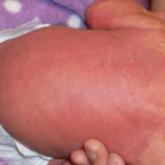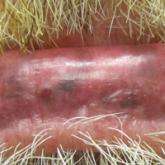Article
Sjögren-Larsson Syndrome: A Case Report and Literature Review
Sjögren-Larsson syndrome (SLS) is an autosomal recessive neurocutaneous disorder most commonly seen in the Scandinavian population and...
From the Department of Dermatology, Venereology, and Leprology, K.J. Somaiya Medical College, Everard Nagar, Sion, Chunabhatti, Mumbai, India.
The authors report no conflict of interest.
The eFigures are available in the Appendix in the PDF.
Correspondence: Shital Poojary, MD, DNB, B405, Bhoomi Residency, Mahavir Nagar, Kandivali West, Mumbai 400 067, India (spoojary2004@gmail.com).

Sjögren-Larsson syndrome (SLS) is a rare autosomal-recessive neurocutaneous disorder comprising a triad of ichthyosis, mental retardation, and spastic diplegia or quadriplegia. It has rarely been reported in Asian and Indian populations. We report the case of an Indian patient with SLS who presented with the classical clinical triad and demonstrated characteristic findings on magnetic resonance spectroscopy. In resource-restricted settings where enzymatic and genetic analyses are not available, magnetic resonance spectroscopy serves as a useful adjunct in confirming the diagnosis of SLS.
Practice Points
Sjögren-Larsson syndrome (SLS) is a rare autosomal-recessive neurocutaneous disorder comprising a triad of ichthyosis, mental retardation, and spastic diplegia or quadriplegia.1 The disorder was first described by Sjögren and Larsson2 in 1957. Early reports of SLS were mainly in white patients, with a particularly high prevalence of 8.3 cases per 100,000 individuals in the county of Västerbotten in Sweden.3 Reports of SLS in Asian and Indian populations are rare.4,5 We report a case of SLS in an Indian boy.
A 12-year-old Indian boy born to nonconsanguineous parents after a full-term pregnancy with normal vaginal delivery presented with generalized dry scaly skin that had been present since 2 months of age. He had a history of delayed milestones (ie, facial recognition, sitting without support at 3 years of age), inability to walk, dysarthria, mental retardation). He had never attended school due to subnormal intellectual functioning. He had a single episode of a tonic-clonic seizure at 4 years of age but was not on any regular antiepileptic medication. There was a history of similar skin lesions in one male sibling of the patient and in 2 maternal uncles. None of them survived beyond early childhood, but detailed information regarding the cutaneous and neurologic manifestations in these family members was not available.
Cutaneous examination revealed lamellarlike ichthyosis on the dorsal aspects of the arms and legs (Figure 1A). Ichthyosis with lichenification was present on the neck, axillae, cubital and popliteal fossae, and abdomen (Figure 1B). The palms and soles showed keratoderma. Neurologic examination of the arms revealed mild rigidity and brisk reflexes. Examination of the legs showed marked rigidity, brisk knee jerks, ankle clonus, extensor plantar reflexes, flexion deformity with contractures, and scissor gait. A Goddard (Seguin) formboard test was performed and indicated a mental age of 4 years. The patient’s IQ was in the range of 25 to 30, indicating a severe degree of subnormality in intellectual functioning. The clinical presentation suggested a diagnosis of SLS.
A skin biopsy from the ichthyotic lesion showed hyperkeratosis, acanthosis, and papillomatosis with sparse superficial perivascular lymphocytic infiltrate, thus confirming the diagnosis of lamellar ichthyosis. Fundus examination was normal. Magnetic resonance imaging (MRI) of the brain revealed confluent symmetrical signal abnormalities along the body of the lateral ventricles, white matter in the perioccipital horn, and in deep white matter of centrum semiovale (Figure 2). Magnetic resonance spectroscopy revealed a narrow lipid peak at approximately 1.3 ppm in the region of signal abnormality (Figure 3). Thus, the diagnosis of SLS was confirmed. Measurement of fatty aldehyde dehydrogenase (FALDH) activity and genetic analysis were not performed due to unavailability.
The patient was treated with topical emollients for the ichthyosis. To reduce his dietary intake of long-chain fatty acids and increase the intake of omega-3 and omega-6 fatty acids, the patient’s parents were advised to use canola, mustard, and/or coconut oil for cooking for the patient, and skim milk was recommended instead of whole milk. Neurodevelopmental techniques in the form of stretching exercises were given to maintain his range of movements. Gutter splints were given to maintain the knees in extension for physiological standing and to prevent osteoporosis. Subsequently, the patient also underwent a multilevel soft-tissue release (hip and knee joints) to relieve the contractures. These measures resulted in considerable improvement and the patient was able to walk with support.

Figure 3. Single-voxel magnetic resonance spectroscopy showed location of voxels (2 and 3) in the occipital trigone area (A) and a characteristically abnormal lipid peak at 1.3 ppm in both voxel locations. The peak was characteristically tall and narrow (arrow)(B). Other peaks seen in the graph are N-acetylaspartate at 2.02 ppm, creatine at 3.02 ppm, and choline at 3.22 ppm.
Sjögren-Larsson syndrome (SLS) is an autosomal recessive neurocutaneous disorder most commonly seen in the Scandinavian population and...

We present a unique case of 3 vascular malformations—Sturge-Weber syndrome (SWS), facial infantile hemangioma (IH), and cutis marmorata...

A 55-year-old man presented with hyperpigmented brown macules on the lips, hands, and fingertips of 6 years’ duration...
